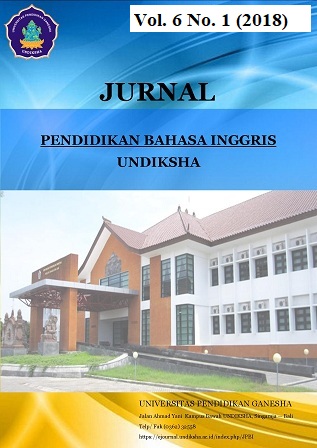THE USE OF R.A.P. PARAPHRASING STRATEGY TO IMPROVE STUDENTS’ READING COMPREHENSION AT CLASS X.A3 IN SMKN 2 SINGARAJA IN ACADEMIC YEAR 2013/2014
DOI:
https://doi.org/10.23887/jpbi.v6i1.20385Abstract
The study was categorized as classroom action research which was done for the purpose of improving the students’ reading comprehension at Class X.A3 in SMKN 2 Singaraja in academic year 2013/2014 through the implementation of R.A.P Paraphrasing strategy. The study was done in two cycles where each cycle consisted of four main activities; planning, action, observation and reflection. To collect the data, there were three kinds of instrument used namely researcher’s diary, questionnaire, and tests. Furthermore, the data obtained in this study were analyzed quantitatively and qualitatively. The data gained in pre-test and post-tests were analyzed quantitatively, while the data from researcher’s diary and questionnaire were analyzed qualitatively. Based on the results of this study, it was found that the students’ reading comprehension at Class X.A3 in SMKN 2 Singaraja had improved significantly. It was indicated by the result of students’ tests on which in pre-test, from 35 students in total, there were only 14.29% students passing the school passing grade. But in post-test I, the number increased into 71.43% students, and finally in post-test II, the criteria of success had been reached as 85.71% students could successfully pass the standard passing score. In addition, the success of the study was also based on the results of the questionnaire as well as the researcher’s diary which showed the students’ positive attitudes toward the implementation of the R.A.P. Paraphrasing strategy in their reading activities.
Keywords : reading comprehension, R.A.P. paraphrasing strategy, English subject in vocational school
References
Blume, C. (2010). RAP: A Reading Comprehension for Students with Learning Disabilities. College of Education and Human Sciences, 1-53.
Fisk, C., & Hurst, B. (2003). Paraphrasing for Comprehension. The Reading Teacher, 182.
Gay, L., Mills, G., & Airasian, P. (2009). Educational Research. New Jersey: Pearson Education International.
Kemendikbud. (2013). Peraturan Menteri Pendidikan dan Kebudayaan Republik Indonesia Nomor 70 Tahun 2013 tentang Kerangka Dasar dan Struktur Kurikulum Sekolah Menengah Kejuruan/Madrasah Aliyah Kejuruan. Menteri Pendidikan dan Kebudayaan Republik Indonesia.
Kemmis, S., & McTaggart, R. (1988). Active Research Planner. Victoria: Deaken University Press.
Magar, L. (2009, July 21). What Makes a Teacher Ineffective. Retrieved from Education Space: http://www.educationspace360.com
Nation, K. (2004, November 27). Children's Reading Comprehension Difficulties. pp. 248-266.
Pearson, D. (2004). The Roots of Reading Comprehension Instruction. University of California.
Pressley, M. (2000, September). Comprehension Instruction: What Makes Sense Now, What Might Make Sense Soon. Retrieved from Reading Online: http://www.readingonline.org
Schumaker, J., Denton, P., & Deshler, D. (1984). The Paraphrasing Strategy. Learning Strategies Curriculum.
Downloads
Published
Issue
Section
License
Authors who publish with the Jurnal Pendidikan Bahasa Inggris Undiksha agree to the following terms:- Authors retain copyright and grant the journal the right of first publication with the work simultaneously licensed under a Creative Commons Attribution License (CC BY-SA 4.0) that allows others to share the work with an acknowledgment of the work's authorship and initial publication in this journal
- Authors are able to enter into separate, additional contractual arrangements for the non-exclusive distribution of the journal's published version of the work (e.g., post it to an institutional repository or publish it in a book), with an acknowledgment of its initial publication in this journal.
- Authors are permitted and encouraged to post their work online (e.g., in institutional repositories or on their website) prior to and during the submission process, as it can lead to productive exchanges, as well as earlier and greater citation of published work. (See The Effect of Open Access)













